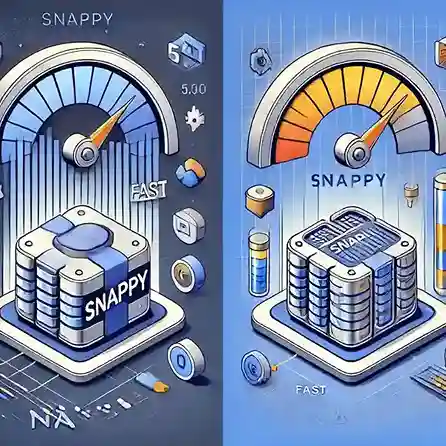Snappy Compression
admin
Snappy Compression Google Snappy #Snappy compression algorithm #Lossless data compression #High-speed compression #Fast compression algorithm
What Is Snappy Compression? A Guide to Fast and Efficient Data Compression
Among the many compression algorithms available, Snappy Compression has emerged as a favorite for applications that demand speed and performance. Developed by Google, Snappy offers a lightweight, lossless compression solution that excels in real-time applications and big data processing. In this article, we delve into what Snappy Compression is, how it works, and why it is widely used.

Introduction
Snappy is a high-speed compression and decompression library designed for applications where speed is a priority. Unlike traditional compression libraries that focus on achieving maximum compression ratios, Snappy optimizes for rapid processing while maintaining moderate compression efficiency. Developed by Google, Snappy is widely used in big data processing, databases, and data streaming applications.
Why Use Snappy for Compression?
Snappy offers several advantages that make it a preferred choice for modern data-driven applications:
- Ultra-fast Compression and Decompression: Designed for performance, Snappy can process data at speeds significantly higher than traditional compression libraries.
- Low CPU Overhead: Unlike gzip or bzip2, Snappy minimizes the computational burden, making it ideal for real-time applications.
- Compatibility with Big Data Frameworks: Snappy is widely supported across platforms like Hadoop, Spark, Cassandra, and Kafka.
- Balanced Compression Ratio: While not the highest in compression efficiency, Snappy strikes a balance between speed and storage optimization.
How to Implement Snappy Compression in Python
Using Snappy in your application is straightforward. Google provides libraries and APIs for multiple programming languages. Below is a simple example using the python-snappy library:
import snappy
# Compress data
original_data = b"This is a test string for Snappy Compression."
compressed_data = snappy.compress(original_data)
# Decompress data
decompressed_data = snappy.uncompress(compressed_data)
print("Original Data:", original_data)
print("Compressed Data:", compressed_data)
print("Decompressed Data:", decompressed_data)
Applications of Snappy Compression
Snappy is widely used in various industries where speed and efficiency are crucial. Some common use cases include:
1. Big Data Processing
Frameworks like Apache Hadoop and Apache Spark use Snappy for compressing intermediate data, reducing processing time and improving performance.
2. Databases
Databases such as Apache Cassandra, RocksDB, and MongoDB leverage Snappy to optimize storage and enhance read/write speeds without significant CPU overhead.
3. Data Streaming
Platforms like Apache Kafka utilize Snappy for real-time data compression, ensuring low latency in message delivery and improving throughput.
4. File Systems
Distributed file systems such as Apache HBase and Google’s Bigtable use Snappy to enhance data storage and retrieval performance.
How to Use Snappy in Different Big Data Technologies
Snappy is natively supported across various big data tools and technologies. Here’s how it integrates with popular frameworks:
1. Using Snappy with HBase
Snappy can be enabled as a compression codec in HBase to optimize storage and query speeds.
2. Using Snappy with Hive or Impala
Hive and Impala support Snappy for compressing table data, improving query performance while reducing storage costs.
3. Using Snappy with MapReduce
Snappy is frequently used in Hadoop MapReduce jobs to compress and decompress large datasets efficiently.
4. Using Snappy with Pig
Apache Pig supports Snappy compression for reducing processing time and improving overall data pipeline efficiency.
5. Using Snappy with Spark SQL
Snappy is a default compression format in Spark SQL when working with Parquet and ORC file formats, enabling faster query execution.
6. Using Snappy with Sqoop 1 and Sqoop 2 Imports
When transferring data between Hadoop and relational databases, Snappy helps compress large data sets to reduce disk space and enhance performance.
Conclusion
Snappy Compression is a game-changer for applications that prioritize speed and efficiency. Its ability to compress and decompress data at lightning-fast speeds makes it an indispensable tool for modern systems handling large volumes of data. While it may not provide the highest compression ratios, its real-time performance and integration with big data environments make it an excellent choice for developers and data engineers. By incorporating Snappy into your workflow, you can ensure optimized storage and accelerated data processing, making your applications more efficient and responsive.
Related Topics:
- How to Enable Snappy in Hadoop
- Optimizing Snappy Compression for Large-Scale Data
- Snappy vs. Gzip: Which Compression Format to Choose?
By following this guide, you can effectively leverage Snappy to enhance performance in your data processing and storage applications. For more tutorials on data compression and big data technologies, stay tuned to our blog!